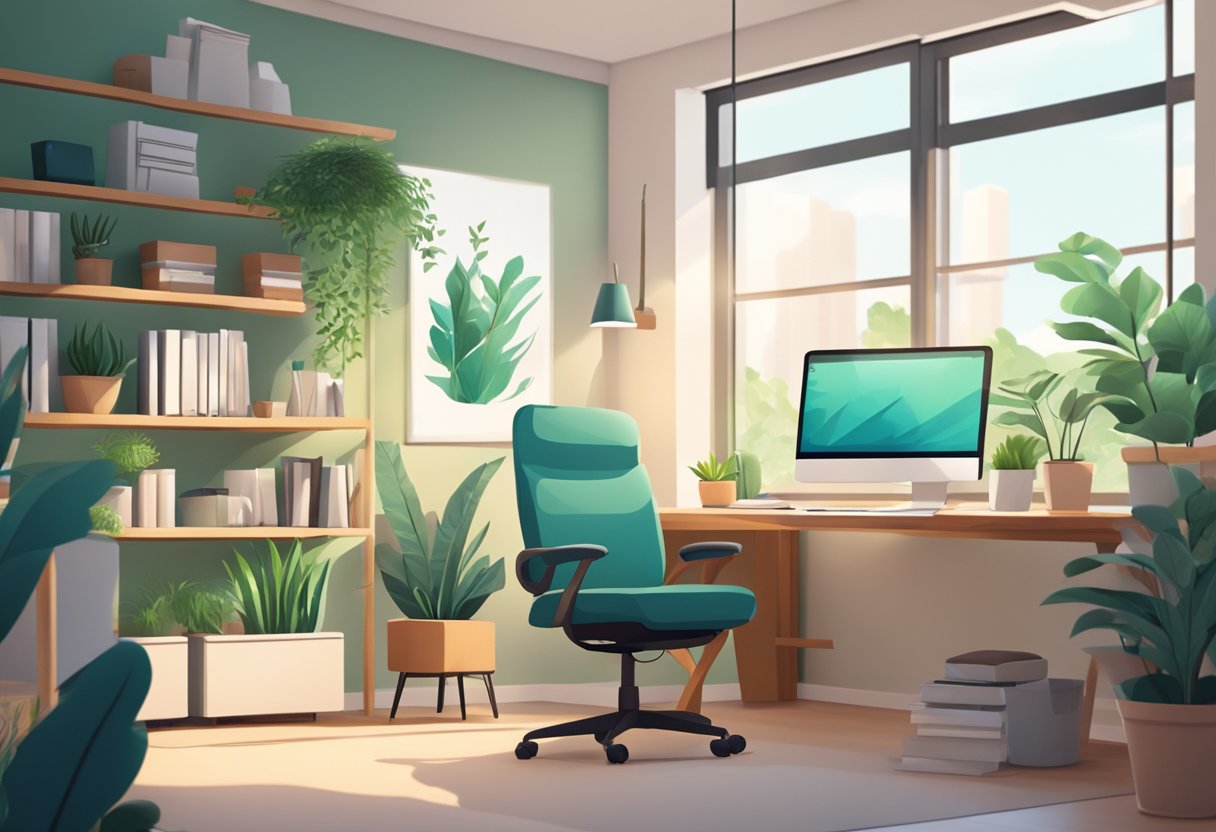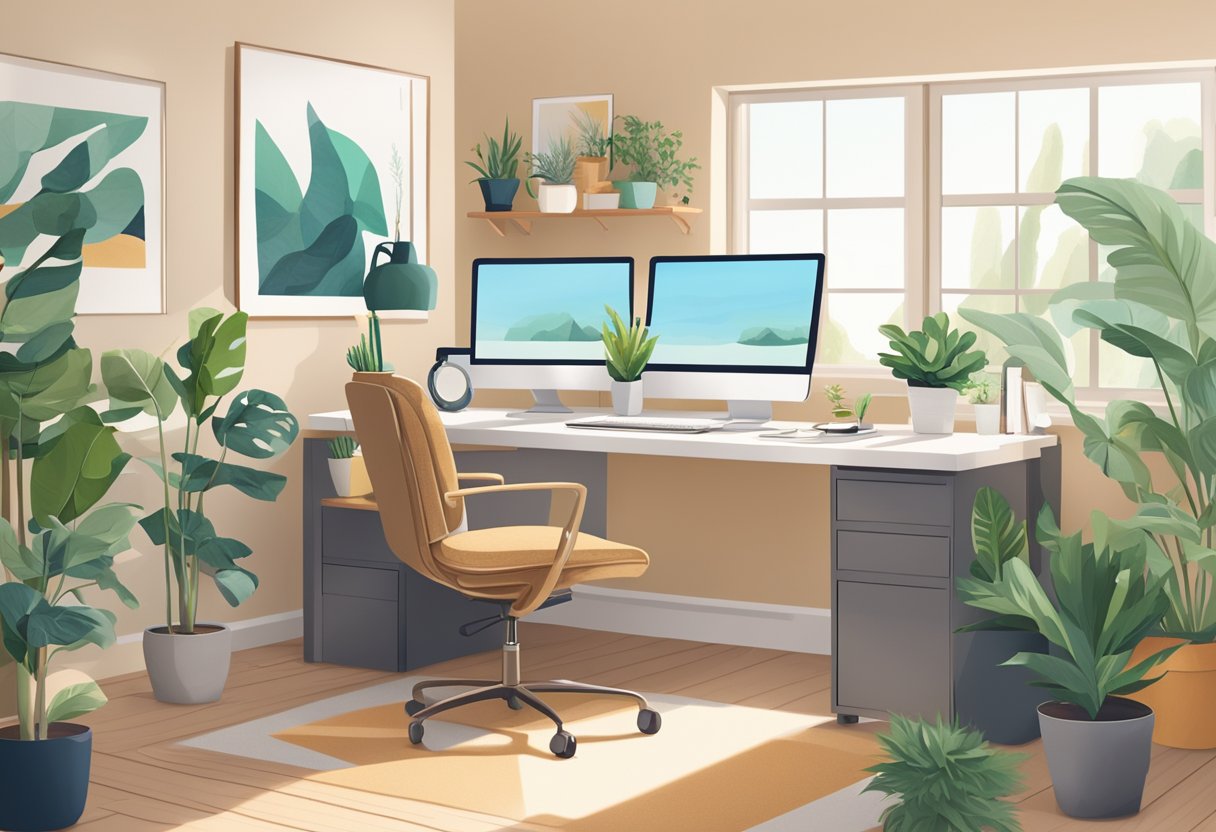A significant part of stress reduction for busy professionals starts with creating a workspace that promotes mental well-being. To achieve a stress-reducing office space, consider organizing your workspace to minimize clutter and distractions. Reducing noise levels and ensuring a comfortable, ergonomic workstation can greatly enhance your productivity and overall performance.

Integrating small breaks throughout your workday can also make a big difference. Taking brief 5- to 10-minute breaks for deep breathing or mindfulness exercises can help in reducing anxiety and refreshing your mind. Practices like these are essential for maintaining your mental well-being amidst a demanding work environment.
Additionally, incorporating elements that evoke calmness and positivity, such as natural light and plants, can contribute to a healthier and more enjoyable workspace. These changes are simple yet effective strategies to transform your office into a sanctuary that supports both your professional and personal growth.
Understanding Workplace Stress

Popular Posts
- Massage Gun vs. Foam Roller: Which Recovery Tool Reigns Supreme?
- 27 Best Calisthenics Exercises for Full-Body Strength and Fitness
- 10 HIIT Workouts for Busy Professionals: Max Fitness, Min Time
- Good Posture Working from Home: Optimize Your Workspace to Prevent Discomfort and Health Issues
- The Best Crossfit Exercises for Full-Body Conditioning
Recognizing workplace stress and understanding its impact on both mind and body is crucial for maintaining overall health and productivity. Stress can manifest in various ways and can have long-term effects if left unmanaged.
Identifying Symptoms of Work-Related Stress
Workplace stress can trigger numerous symptoms that affect your mental and physical well-being. Common signs include fatigue, frequent headaches, and muscle tension. Additionally, you may experience irritability and anxiety. These symptoms can be a reaction to high-pressure environments or persistent demands at work. The American Psychological Association notes that prolonged stress can spill over into your personal life, exacerbating both mental and emotional health issues.
The Impact of Chronic Stress on Professionals
Chronic stress in the workplace can lead to severe health problems. Beyond the immediate symptoms like headaches and muscle tension, chronic stress may increase the risk of long-term conditions such as hypertension and cardiovascular diseases. The continuous stress reaction also negatively influences your mental health, contributing to anxiety and depression.
To reduce the risk, it’s essential to implement effective stress management techniques and make your work environment more conducive to mental wellness. Learn to set boundaries and incorporate breaks into your daily routine to mitigate stress.
Psychological Theories and Studies
Psychological theories provide insight into how stress affects professionals. The Demand-Control Model suggests that jobs with high demands and little control over tasks increase stress levels. Similarly, the Effort-Reward Imbalance Model posits that stress arises when the effort put into work is not matched by the rewards received.
Studies have shown that stress management strategies such as Progressive Muscle Relaxation (PMR) and regular exercise can significantly reduce stress. Keeping a stress journal has also proven effective in identifying stressors and understanding how they impact your daily life.
Incorporate these strategies into your routine to maintain better mental health and well-being. Stress management in the workplace is not just about reducing stress but also about ensuring you build resilience against it.
Designing Your Office Space for Reduced Stress
Creating a stress-reducing office space involves optimizing lighting and temperature, incorporating greenery and natural elements, and ensuring ergonomic and comfortable furnishings. These elements can significantly enhance your work environment, contributing to improved productivity and well-being.
Optimizing Lighting and Temperature
Adequate lighting and temperature control are crucial for a productive workspace. Natural light positively impacts mood and energy levels, so position your desk near a window if possible. If natural light is limited, use full-spectrum lighting to mimic daylight.
Temperature regulation is equally important. Aim for a consistent, comfortable temperature—typically around 70-72°F (21-22°C). Overly hot or cold offices can lead to discomfort and distraction. Utilize fans or heaters to maintain a pleasant climate.
Task lighting can also enhance focus, especially during late hours. Adjustable desk lamps with LED bulbs are a good choice as they offer flexibility and reduce eye strain.
Incorporating Greenery and Natural Elements
Adding plants to your office space can greatly reduce stress. Greenery not only improves air quality but also promotes a sense of calm and well-being. Easy-to-maintain options like snake plants, spider plants, or succulents are ideal for office environments.
Placing plants at various points in your workspace—such as your desk, shelves, or window sills—adds visual interest and a connection to nature.
Consider using other natural elements like wooden furniture or stone decorations to enhance the organic feel. These materials create a more inviting and soothing atmosphere compared to synthetic alternatives.
The Importance of Ergonomics and Comfort
Ergonomic design is vital for long hours at a desk. Start with a supportive chair that offers adjustable height, backrest, and armrests to maintain proper posture.
Arrange your workstation so your computer screen is at eye level to prevent neck strain. An ergonomic keyboard and mouse can reduce the risk of repetitive strain injuries.
Comfortable yet practical desk accessories like wrist rests or footstools can further enhance your workspace. Regularly adjust your posture and take short breaks to stretch and move around, which can reduce the physical stresses associated with prolonged sitting.
Making these adjustments will not only foster a more comfortable work environment but also significantly reduce stress.
Creating a Supportive Culture
Establishing a supportive culture can significantly enhance stress management in the workplace. By promoting open communication, organizing team-building activities, and utilizing employee assistance programs, you create a strong support network that contributes to better relationships and mental well-being.
Fostering Open Communication
Open communication is key to maintaining a healthy work environment. Encourage employees to share their ideas and concerns freely. This creates a sense of belonging and makes individuals feel valued.
Create safe spaces for dialogue. You can implement regular check-ins and feedback sessions. Leaders should be approachable and responsive, promoting a culture where constructive feedback is welcomed. This reduces stress and builds trust among team members.
Using platforms like team meetings or suggestion boxes can ensure everyone’s voice is heard. Transparent communication about company goals and changes also helps in aligning team efforts, reducing uncertainties and unnecessary stress.
Implementing Team-Building Activities
Team-building activities strengthen relationships and foster a sense of camaraderie. These activities can range from outdoor adventures and workshops to volunteering opportunities. They provide a break from routine tasks and help team members connect on a personal level.
Choose activities that align with your team’s interests. Think beyond traditional exercises and consider creative options like virtual escape rooms or charity runs. Regularly scheduled activities can keep the enthusiasm alive and contribute to a supportive atmosphere.
Team-building exercises improve collaboration and problem-solving skills. They create lasting memories and relationships, making the work environment more pleasant and cohesive. These activities also play a crucial role in stress management, allowing employees to unwind and recharge.
Leveraging Employee Assistance Programs
Employee Assistance Programs (EAPs) provide valuable resources for mental well-being. They offer confidential counseling, support services, and resources to help employees manage stress effectively. EAPs can address various concerns, from personal issues to work-related stressors.
Promote awareness of these programs within your organization. Ensure that employees know how to access these services and feel comfortable using them. Regular reminders and easy access to information can increase participation rates.
EAPs can also include workshops on stress management, mental health, and work-life balance. By leveraging these programs, you show a commitment to your team’s overall well-being, creating a supportive, caring workplace culture.
Personal Strategies for Managing Workplace Stress
Managing workplace stress involves various approaches, including effective time management and organization, maintaining clear boundaries while prioritizing self-care, and seeking professional help when needed. Each strategy contributes significantly to reducing stress and improving mental well-being at work.
Time Management Techniques and Organization
Effective time management and organization are key to reducing workplace stress. Start by creating a daily schedule that prioritizes important tasks and allocates specific time slots for each. Using tools like calendars and project management apps can help you keep track of deadlines and responsibilities.
To avoid procrastination, break large tasks into smaller, manageable steps. This makes tasks less daunting and easier to tackle, enhancing productivity. Keeping your workspace organized also plays a crucial role in stress management. An uncluttered environment can enhance decision-making and reduce distractions, contributing to job satisfaction. Implementing these strategies helps create a more supportive work environment, making it easier to handle conflicts and pressures.
Setting Boundaries and Prioritizing Self-Care
Setting boundaries at work is essential for maintaining mental health. Clearly communicate your availability and limits to your colleagues and supervisors. This helps prevent overcommitment and ensures you have time for yourself. Incorporating self-care into your routine is equally important. Activities such as exercise, meditation, and spending time with loved ones can enhance resilience against stress.
Avoid bringing work home by designating specific times to disconnect from work-related activities. Prioritizing self-care boosts your overall well-being, making you more effective and focused during work hours. Remember, a balanced life outside of work contributes significantly to reducing stress and increasing job satisfaction.
The Role of Professional Help in Stress Management
Seeking professional help can be a crucial step in managing workplace stress. Therapists and counselors provide valuable insights and tools for coping with stress. They can help identify the root causes of your stress and develop personalized strategies to address them. Some companies offer Employee Assistance Programs (EAPs), which provide access to confidential counseling services.
If workplace stress impacts your mental health, consider discussing your concerns with a mental health professional. They can offer guidance on issues like conflict resolution and decision-making. Accessing professional help ensures you have the support needed to manage stress effectively, contributing to a healthier work environment and enhanced personal well-being.
Harnessing the Power of Productivity and Creativity
To harness productivity and creativity in an office setting, focus on techniques that enhance concentration and cultivate a positive mental attitude. Effective methods can lead to improved performance, better work-life balance, and a more satisfying workplace experience.
Enhancing Focus and Concentration
Improving focus and concentration is crucial for productivity. Start by creating a designated workspace free of distractions. Use ergonomic furniture to maintain comfort and reduce physical strain.
Time management techniques such as the Pomodoro Technique can break work into manageable intervals with short breaks, boosting focus. Implementing task prioritization—tackling high-priority tasks first—can prevent overwhelm and keep you on track.
Technology can also aid focus. Noise-canceling headphones can reduce background noise, and productivity apps can block distracting websites. Keeping a consistent work schedule helps establish routine and mental discipline.
Mindfulness practices such as meditation or deep breathing exercises can enhance your ability to concentrate. These practices calm the mind and refresh your mental capacity, allowing you to stay engaged with your tasks over longer periods.
Cultivating a Positive Mood and Mental Attitude
Cultivating a positive mood is vital for creativity and mental well-being. Begin by incorporating natural elements into your workspace. Plants, natural light, and even artwork can positively influence your mood and reduce stress.
Physical activity is another essential element. Regular exercise, whether through scheduled workouts or short walks during breaks, can boost both mood and energy levels. This physical movement helps to clear mental blockages and sparks creativity.
Work-life balance is crucial. Setting boundaries for working hours and ensuring adequate rest can prevent burnout. Flexible work policies can help accommodate personal needs, fostering a positive attitude and higher job satisfaction.
Social connections also play a role. Encourage collaboration and team-building activities. Regular check-ins with colleagues can foster a sense of community, enhancing mental well-being and overall creativity in the workplace.
Frequently Asked Questions
This section provides practical tips for creating a stress-free office environment through effective gadgets, activities, and strategies that cater specifically to busy professionals.
What are effective office gadgets that help reduce stress?
Certain gadgets can make a significant difference in your workday. Noise-canceling headphones, for example, help maintain focus by eliminating background noise. Consider a desk organizer to keep your workspace clutter-free, which can reduce stress.
Can you suggest some ideas for stress relief in the office environment?
Simple techniques such as taking brief breaks for deep breathing exercises or sipping a cup of tea can be transformative. Adding plants to your office can also provide a calming effect and improve air quality.
What activities can be introduced in the workplace to help employees alleviate stress?
Mindfulness sessions and yoga classes during lunch breaks can be beneficial. Such activities not only help in reducing stress but also increase overall productivity and employee satisfaction.
What are the top methods professionals can practice to lower stress levels at work?
Practicing progressive muscle relaxation (PMR) and keeping a stress journal are effective methods. PMR involves systematically tensing and relaxing different muscle groups to release tension, while a stress journal helps in identifying and managing stressors.
What gifts are considered beneficial for relieving stress among office workers?
Consider gifting items like stress balls, essential oil diffusers, or ergonomic chairs. These gifts can make a tangible difference in creating a comfortable and relaxing workspace.
What strategies can employers implement to create a less stressful work atmosphere?
Employers can implement regular check-ins to clarify expectations and workloads. Also, promoting a culture that values work-life balance by encouraging employees to take regular breaks can significantly reduce stress levels in the workplace.





